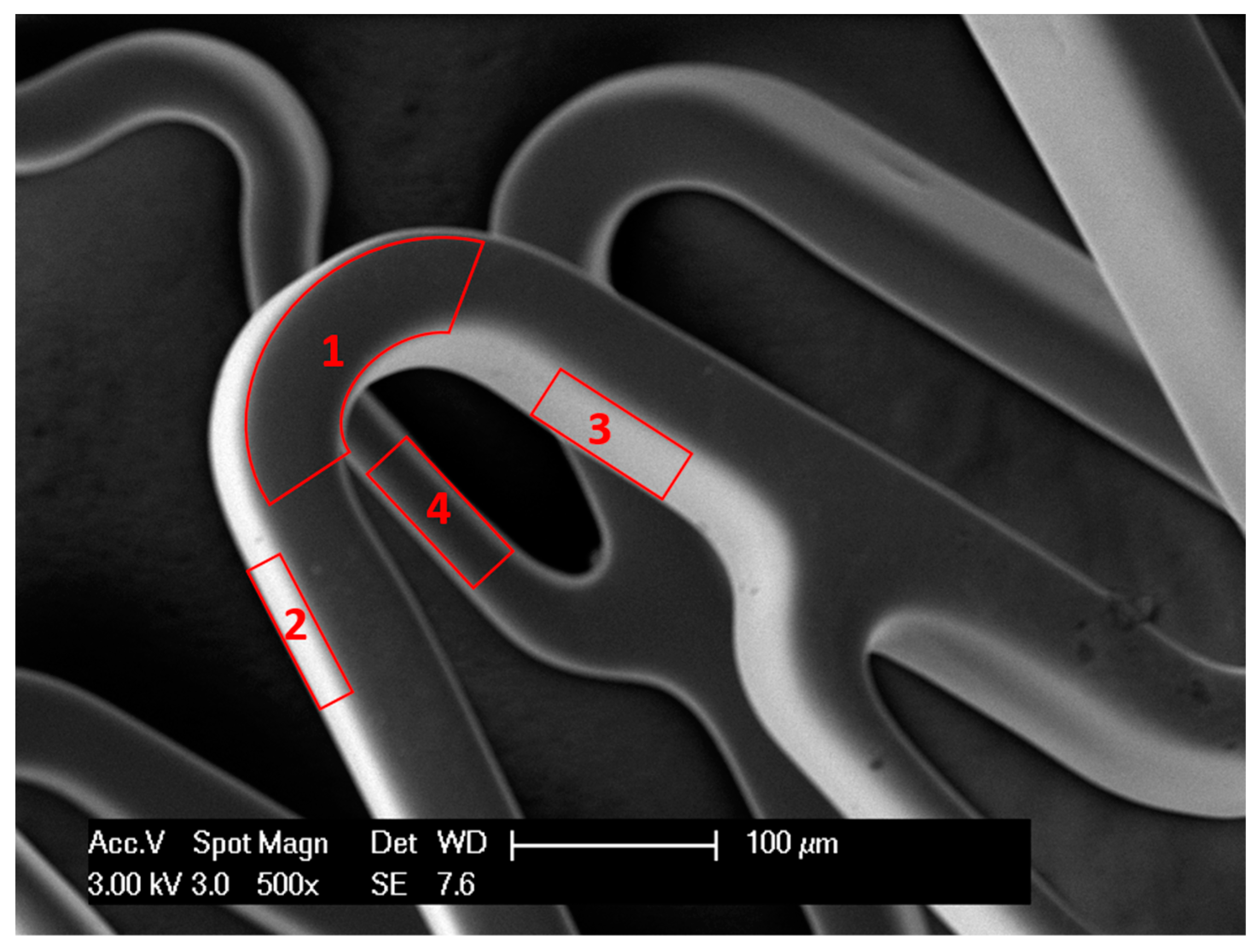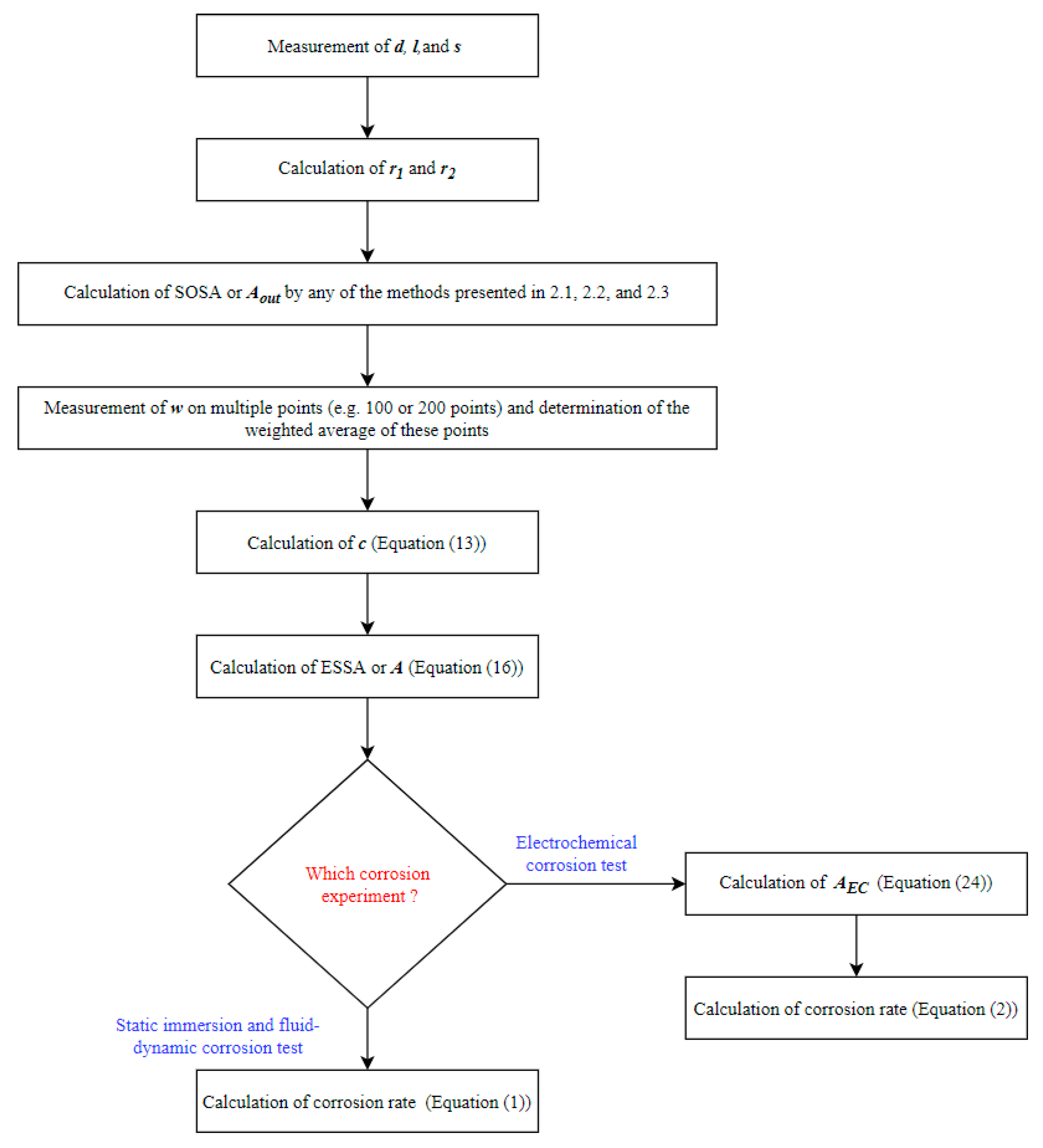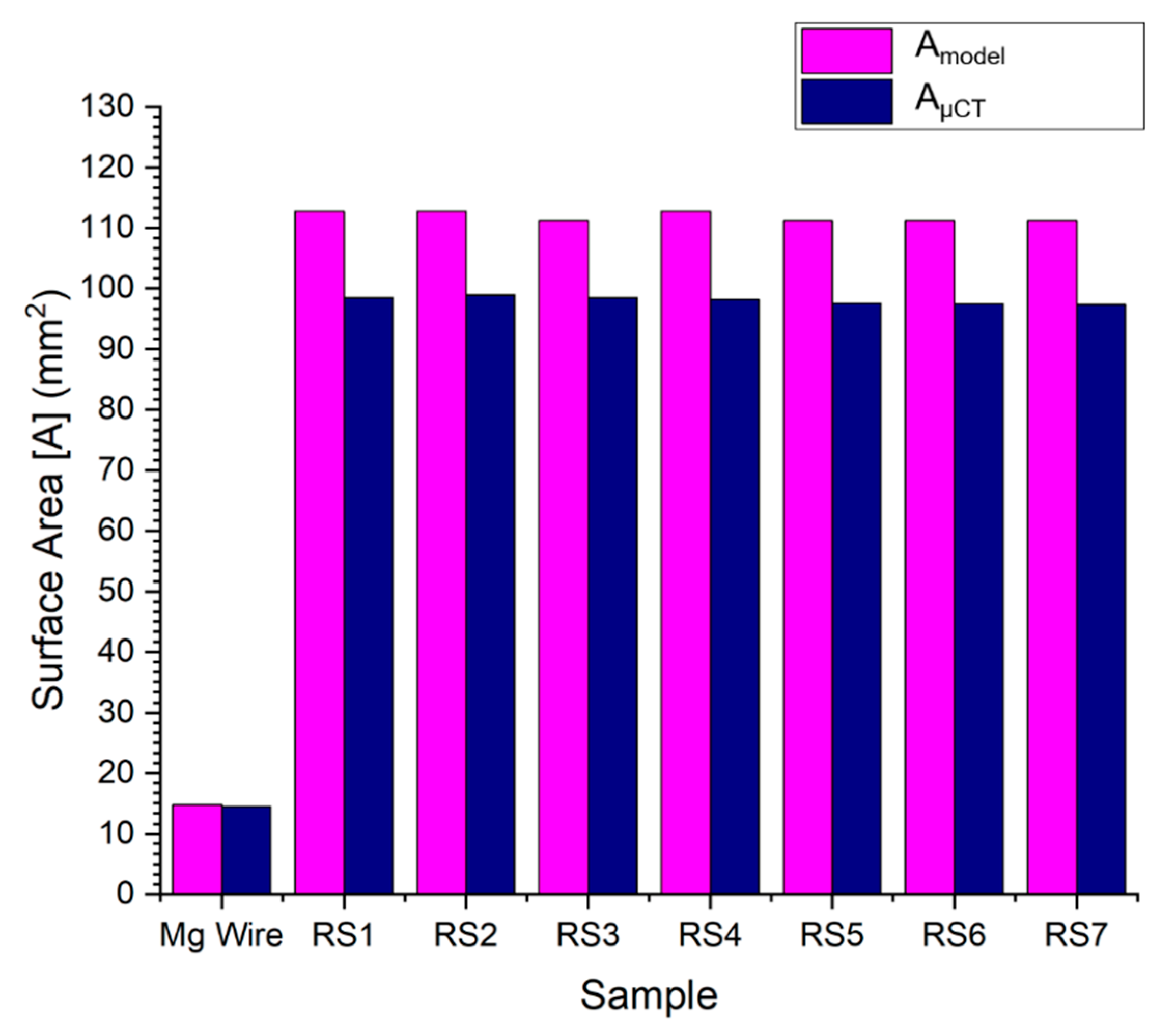Determination of the Entire Stent Surface Area by a New Analytical Method
Abstract
:1. Introduction
2. Stent Outer Surface Area (SOSA)
2.1. Calculation Method
2.2. Manual Method
2.3. Automatic Method
3. Entire Stent Surface Area (ESSA)
3.1. Value of c
3.2. Value of w
4. Algorithm of the New Model for Corrosion Rate Calculation
5. Validation of the New Mathematical Model
- Surface area calculation of the simpler samples by micro-CT [23].
- Samples with a different geometry and material were selected (Figure 5).
- Micro-CT needs a reference volume for the surface area calculation of samples. Two different methods were used for the volume calculation of samples.
- Micro-CT measurement of samples was conducted.
- Reference volume by mass was used for the surface area calculation of samples.
- Surface area calculation of stents by micro-CT.
- Volume determination of stents by mass.
- Micro-CT measurement of Mg alloy stent samples was conducted.
- Surface area calculation using the reference volume by mass.
- Comparison of the results by model and micro-CT.
Micro-CT Measurement
6. Results
7. Discussion
8. Conclusions
Author Contributions
Funding
Acknowledgments
Conflicts of Interest
References
- Serruys, P.W.; Morice, M.-C.; Kappetein, A.P.; Colombo, A.; Holmes, D.R.; Mack, M.J.; Ståhle, E.; Feldman, T.E.; Brand, M.V.D.; Bass, E.J.; et al. Percutaneous Coronary Intervention versus Coronary-Artery Bypass Grafting for Severe Coronary Artery Disease. N. Engl. J. Med. 2009, 360, 961–972. [Google Scholar] [CrossRef] [PubMed]
- Schmidt, T.; Abbott, J. Coronary Stents: History, Design, and Construction. J. Clin. Med. 2018, 7, 126. [Google Scholar] [CrossRef] [PubMed] [Green Version]
- Silvain, J.; Cayla, G.; Collet, J.-P.; Montalescot, G.; Fargeot, C. Coronary Stents: 30 Years of Medical Progress. Medecine/Sciences 2014, 30, 303–310. [Google Scholar] [CrossRef] [PubMed] [Green Version]
- MacNeill, B.D.; Jang, I.K.; Wong, P. Coronary Stents. In Clinical, Interventional and Investigational Thrombocardiology; CRC Press: Boca Raton, FL, USA, 2005; pp. 453–472. [Google Scholar] [CrossRef]
- Boccalini, S. CT Imaging of the Thoracic Aorta: Size Assessment and Follow-Up after Surgical and Endovascular Intervention; Erasmus University: Rotterdam, The Netherlands, 2019. [Google Scholar]
- Costa, F.; van Klaveren, D.; James, S.; Heg, D.; Räber, L.; Feres, F.; Pilgrim, T.; Hong, M.K.; Kim, H.S.; Colombo, A.; et al. Derivation and Validation of the Predicting Bleeding Complications in Patients Undergoing Stent Implantation and Subsequent Dual Antiplatelet Therapy (PRECISE-DAPT) Score: A Pooled Analysis of Individual-Patient Datasets from Clinical Trials. Lancet 2017, 389, 1025–1034. [Google Scholar] [CrossRef]
- Mohapatra, A.; Saadeddin, Z.; Bertges, D.J.; Madigan, M.C.; Al-Khoury, G.E.; Makaroun, M.S.; Eslami, M.H. Nationwide trends in drug-coated balloon and drug-eluting stent utilization in the femoropopliteal arteries. J. Vasc. Surg. 2020, 71, 560–566. [Google Scholar] [CrossRef] [PubMed]
- Lei, Y.; Chen, X.; Li, Z.; Zhang, L.; Sun, W.; Li, L.; Tang, F. A New Process for Customized Patient-Specific Aortic Stent Graft Using 3D Printing Technique. Med. Eng. Phys. 2020, 77, 80–87. [Google Scholar] [CrossRef] [PubMed]
- Saito, Y.; Grubman, D.; Cristea, E.; Lansky, A. The Firehawk Stent: A Review of a Novel Abluminal Groove-Filled Biodegradable Polymer Sirolimus-Eluting Stent. Cardiol. Rev. 2020, 28, 208–212. [Google Scholar] [CrossRef] [PubMed]
- Majewska, P.; Oledzka, E.; Sobczak, M. Overview of the latest developments in the field of drug-eluting stent technology. Biomater. Sci. 2020, 8, 544–551. [Google Scholar] [CrossRef] [PubMed]
- ASTM. ASTM G102-89 Standard Practice for Calculation of Corrosion Rates and Related Information from Electrochemical Measurements; ASTM International: West Conshohocken, PA, USA, 2010. [Google Scholar] [CrossRef]
- Wong, L.L.; Martin, S.I.; Rebak, R.B.; Columbia, B.; Wong Sue I Martin Raúl B Rebak, L.L. Methods to Calculate Corrosion Rates for Alloy 22 from Polarization Resistance Experiments. In Proceedings of the ASME Pressure Vessels and Piping Conference, Vancouver, BC, Canada, 23–27 July 2006; pp. 571–580. [Google Scholar]
- Gastaldi, D.; Sassi, V.; Petrini, L.; Vedani, M.; Trasatti, S.; Migliavacca, F. Continuum Damage Model for Bioresorbable Magnesium Alloy Devices—Application to Coronary Stents. J. Mech. Behav. Biomed. Mater. 2011, 4, 352–365. [Google Scholar] [CrossRef] [PubMed]
- Grogan, J.A.; Leen, S.B.; McHugh, P.E. A Physical Corrosion Model for Bioabsorbable Metal Stents. Acta Biomater. 2014, 10, 2313–2322. [Google Scholar] [CrossRef] [PubMed] [Green Version]
- Grogan, J.A.; Leen, S.B.; McHugh, P.E. Computational Micromechanics of Bioabsorbable Magnesium Stents. J. Mech. Behav. Biomed. Mater. 2014, 34, 93–105. [Google Scholar] [CrossRef] [PubMed]
- Ma, Z.M.; Dong, H.Y.; Qi, M. A Study on Fatigue Test for Cardiovascular Stent. Appl. Mech. Mater. 2012, 157–158, 197–201. [Google Scholar] [CrossRef]
- Pelton, A.R.; Schroeder, V.; Mitchell, M.R.; Gong, X.-Y.; Barney, M.; Robertson, S.W. Fatigue and Durability of Nitinol Stents. J. Mech. Behav. Biomed. Mater. 2008, 1, 153–164. [Google Scholar] [CrossRef] [PubMed]
- Hertel, M.; Laule, M.; Zinelis, S.; Imiolczyk, S.M.; Mueller, W.-D. Electrochemical Characterization of Vascular Bare-Metal Stents. A Novel Approach Modifying the Mini-Cell System. SDRP J. Biomed. Eng. 2016, 1, 1–11. [Google Scholar]
- Hertel, M. Elektrochemische Charakterisierung von Stents Mit Hilfe Des Adaptierten Mini-Cell-Systems (MCS)–Teil II. Ph.D. Thesis, Charité Universitätsmedizin, Berlin, Germany, 2012. [Google Scholar]
- Károly, D.; Asztalos, L.; Fazakas, É. Corrosion Behaviour Of Overlapping Coronary Artery Stents. In Proceedings of the 34th Danubia-Adria Symposium on Advances in Experimental Mechanics, Trieste, Italy, 19–22 September 2017; pp. 1–3. [Google Scholar]
- Károly, D.; Kovács, M.; Terdik, A.A.; Bognár, E. Investigation of Metallic Surface Area of Coronary Stents. Biomech. Hung. 2013, 6, 205–212. [Google Scholar] [CrossRef]
- Kovács, M.; Károly, D.; Dévényi, L. Comparing Two Examination Methods for Measuring Metal to Artery Ratio of Coronary Stents. Mater. Sci. Forum 2015, 812, 113–118. [Google Scholar] [CrossRef]
- Saqib, M.; Bernhardt, R.; Kästner, M.; Beshchasna, N.; Cuniberti, G.; Opitz, J. Application of ΜCT for the Determination of Total Surface Area of Stents. In Proceedings of the 7th E-Health and Bioengineering Conference, EHB 2019, Iasi, Romania, 21–23 November 2019. [Google Scholar] [CrossRef]
- ISO. ISO 25539-2: Cardiovascular Implants-Endovascular Devices—Part 2: Vascular Stents; ISO: Geneva, Switzerland, 2012. [Google Scholar]







| S.No. | Sample | Average Width of Upper Surface | Surface Co-Efficient | Stent Outer Surface Area (SOSA) | Entire Stent Surface Area (ESSA) |
|---|---|---|---|---|---|
| w (mm) | c | Aout (%) | A (mm2) | ||
| 1 | RS-I | 0.121 | 1.03 | 33.62 | 112.77 |
| 2 | RS-II | 0.121 | 1.03 | 33.62 | 112.77 |
| 3 | RS-III | 0.121 | 1.03 | 33.14 | 111.18 |
| 4 | RS-IV | 0.121 | 1.03 | 33.62 | 112.77 |
| 5 | RS-V | 0.121 | 1.03 | 33.14 | 111.18 |
| 6 | RS-VI | 0.121 | 1.03 | 33.14 | 111.18 |
| 7 | RS-VII | 0.121 | 1.03 | 33.14 | 111.18 |
| S.No. | Sample | Volume | ESSA | Difference | ||
|---|---|---|---|---|---|---|
| Calculated | Micro-CT | Calculated | Micro-CT | - | ||
| VModel (mm3) | VµCT (mm3) | AModel (mm2) | AµCT (mm2) | % | ||
| 1 | Mg alloy wire | 1.59 | 1.59 | 14.77 | 14.45 | 2.17 |
| 2 | RS-I | 3.70 | 3.67 | 112.77 | 98.49 | 12.66 |
| 3 | RS-II | 3.70 | 3.66 | 112.77 | 98.95 | 12.26 |
| 4 | RS-III | 3.65 | 3.63 | 111.18 | 98.49 | 11.42 |
| 5 | RS-IV | 3.70 | 3.70 | 112.77 | 98.20 | 12.92 |
| 6 | RS-V | 3.65 | 3.65 | 111.18 | 97.53 | 12.28 |
| 7 | RS-VI | 3.65 | 3.63 | 111.18 | 97.41 | 12.39 |
| 8 | RS-VII | 3.65 | 3.63 | 111.18 | 97.34 | 12.45 |
Publisher’s Note: MDPI stays neutral with regard to jurisdictional claims in published maps and institutional affiliations. |
© 2020 by the authors. Licensee MDPI, Basel, Switzerland. This article is an open access article distributed under the terms and conditions of the Creative Commons Attribution (CC BY) license (http://creativecommons.org/licenses/by/4.0/).
Share and Cite
Saqib, M.; Bernhardt, R.; Kästner, M.; Beshchasna, N.; Cuniberti, G.; Opitz, J. Determination of the Entire Stent Surface Area by a New Analytical Method. Materials 2020, 13, 5633. https://doi.org/10.3390/ma13245633
Saqib M, Bernhardt R, Kästner M, Beshchasna N, Cuniberti G, Opitz J. Determination of the Entire Stent Surface Area by a New Analytical Method. Materials. 2020; 13(24):5633. https://doi.org/10.3390/ma13245633
Chicago/Turabian StyleSaqib, Muhammad, Ricardo Bernhardt, Markus Kästner, Natalia Beshchasna, Gianaurelio Cuniberti, and Jörg Opitz. 2020. "Determination of the Entire Stent Surface Area by a New Analytical Method" Materials 13, no. 24: 5633. https://doi.org/10.3390/ma13245633







